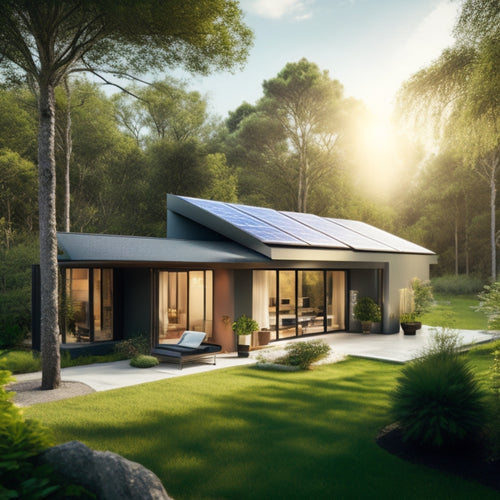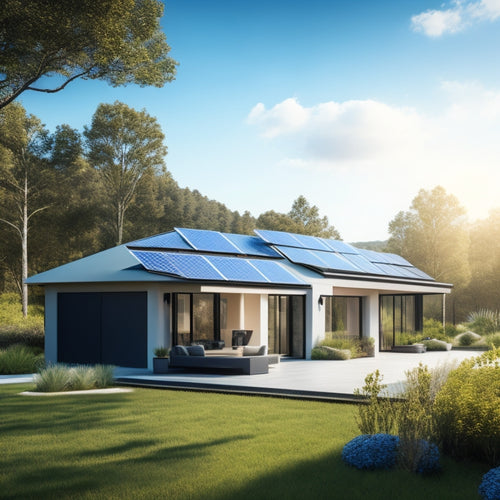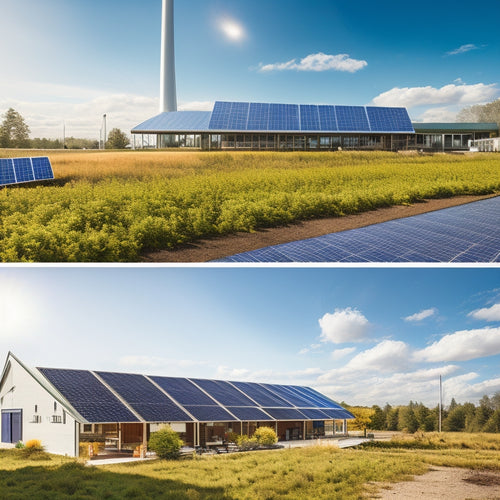
Commercial Installation Essentials: A Comprehensive Checklist
Share
When tackling a commercial installation project, you'll need to cover all the bases to guarantee success. Start by evaluating the site's environmental impact and analyzing soil conditions to establish a solid foundation. Next, design a tailored system plan, procure the right equipment, and obtain necessary permits. Implement quality control measures, and conduct thorough testing and commissioning to ensure peak performance. Finally, conduct a final inspection and handover to confirm everything is in working order. With so many moving parts, a detailed checklist is essential - and you're just getting started.
Key Takeaways
• Conduct a thorough site assessment to identify potential risks, opportunities, and environmental impacts before installation.
• Develop a tailored system design that incorporates site-specific requirements, equipment needs, and unique demands.
• Ensure compliance with local ordinances and regulations by obtaining necessary permits and meeting code requirements.
• Implement quality control protocols during installation to verify equipment compatibility, conduct regular site inspections, and maintain accurate records.
• Verify system performance and functionality through thorough testing and commissioning phases to identify and rectify defects or malfunctions.
Site Assessment and Evaluation
When planning a commercial installation, you must conduct a thorough site assessment and evaluation to identify potential obstacles and opportunities that can impact the project's timeline, budget, and overall success. This involves evaluating the site's environmental impact, including potential hazards and natural resources that may be affected by the installation.
You must also assess the soil conditions, including its composition, stability, and drainage capabilities, to establish a thorough foundation for your installation. A detailed site assessment will help you identify potential risks and opportunities, allowing you to develop strategies to mitigate or capitalize on them.
System Design and Planning
As you move into the system design and planning phase, you'll need to analyze the system requirements, incorporating the findings from your site assessment and evaluation.
This involves identifying the specific needs of the commercial installation, including the type and quantity of equipment required. By doing so, you'll be able to create a tailored system design that meets the unique demands of the site.
System Requirements Analysis
You must identify the operational and performance requirements of your commercial installation project during the system requirements analysis phase, which involves defining the functional and non-functional needs of the system. This phase is important in ensuring that your system meets the necessary requirements to achieve its intended purpose.
To achieve this, you'll need to:
-
Engage with stakeholders to gather requirements and expectations through stakeholder engagement
-
Define the functional requirements, including user interactions and system interfaces
-
Identify non-functional requirements, such as performance, security, and scalability
-
Determine the system's technical debt and develop a plan to address it
-
Develop a detailed requirements document that outlines the system's needs and constraints
Site Assessment and Evaluation
During the site assessment and evaluation phase, you'll assess the existing infrastructure and environmental conditions to identify potential obstacles and opportunities that could impact your commercial installation project's success. This critical step helps you mitigate risks and capitalize on opportunities. You'll evaluate the site's environmental impact, including factors like soil conditions, water tables, and natural habitats. This information will inform your system design and planning.
| Site Assessment Factor | Considerations |
|---|---|
| Soil Conditions | Stability, erosion potential, and foundation requirements |
| Environmental Impact | Potential disruption to natural habitats, water tables, and ecosystems |
| Infrastructure | Existing utilities, access roads, and nearby developments |
| Climate and Weather | Extreme weather conditions, temperature fluctuations, and natural disaster risks |
| Zoning and Regulations | Local ordinances, permits, and compliance requirements |
Permitting and Code Compliance
As you navigate the commercial installation process, you'll need to make sure you're complying with local regulations and obtaining the necessary permits. Failure to do so can result in costly delays, fines, or even project shutdowns.
You'll need to identify the required permits, meet code requirements, and adhere to local ordinances to avoid any potential roadblocks.
Obtaining Necessary Permits
Before commencing a commercial installation project, securing necessary permits from local authorities is essential to guarantee compliance with building codes and regulations. This vital step ensures your project meets the required standards, avoiding costly rework and potential legal issues.
Here's what you need to know about the permit process:
-
Identify the required permits: Determine which permits are necessary for your project, including electrical, plumbing, and building permits.
-
Gather required documents: Collect all necessary documents, including blueprints, specifications, and contractor licenses.
-
Submit your application: Submit your permit application to the relevant municipal authorities, along with the required fees.
-
Wait for approval: Wait for the authorities to review and approve your application, which may involve site inspections.
-
Obtain the permit: Once approved, obtain the permit and display it on the construction site as required by local regulations.
Code Requirements Met
With your permit in hand, you can now focus on guaranteeing your commercial installation project meets all relevant code requirements, avoiding potential rework and ensuring a safe, compliant final product.
You'll need to stay up-to-date on code revisions and regulatory updates that may impact your project. Review the latest International Building Code (IBC) and International Energy Conservation Code (IECC) standards to ensure compliance.
Verify that your installation meets electrical, plumbing, and HVAC codes, as well as accessibility and fire safety standards. Conduct regular inspections to identify and address any potential code violations.
Local Ordinances Adhered
You must acquaint yourself with local ordinances that may supersede or augment national codes, guaranteeing your commercial installation project complies with regional regulations and zoning laws. Failure to do so can result in costly delays, fines, or even project cancellation.
-
Review municipal bylaws and zoning regulations to confirm compliance with local requirements.
-
Verify if any variances or special permits are needed for your project.
-
Confirm that your project meets local building codes, including accessibility and environmental standards.
-
Check if any historic preservation or architectural review board approvals are required.
-
Consult with local authorities to clarify any ambiguities or uncertainties in the ordinances.
Equipment Procurement and Storage
Procuring the right equipment for your commercial installation project involves more than just ordering gear from a supplier or manufacturer. You need to take into account your supply chain and make sure that you're getting the right equipment at the right time.
This means developing a robust inventory management system that tracks your equipment from procurement to deployment. You'll need to identify reliable suppliers, negotiate prices, and manage lead times to make certain that your equipment arrives on site when you need it.
Effective inventory management will help you avoid costly delays and guarantee that your project stays on track. By taking control of your equipment procurement and storage, you'll be well on your way to a successful commercial installation project.
Installation and Quality Control
Now that you've secured the necessary equipment, it's time to focus on the installation process, where meticulous planning and attention to detail are vital to guarantee a smooth and efficient setup.
During this phase, it's important to establish quality metrics to make sure the installation meets the required standards. You should also implement control protocols to monitor and regulate the installation process. This will help identify and rectify any issues promptly, ensuring a high-quality installation.
Some key considerations for installation and quality control include:
- Verifying equipment compatibility and functionality
- Conducting regular site inspections to ensure compliance with quality metrics
- Implementing control protocols for real-time monitoring and issue resolution
- Maintaining accurate records of installation progress and quality control measures
- Conducting thorough testing to ensure system integration and performance
Testing and Commissioning Phase
How do you guarantee that the installed system meets the required specifications and performance criteria?
In the testing and commissioning phase, you'll verify that every component works as intended.
System validation is essential, ensuring the system operates within predetermined parameters.
Conduct thorough tests to identify and rectify any defects or malfunctions.
Field calibration is also important, as it fine-tunes the system to peak performance.
You'll need to simulate real-world scenarios, test alarm and notification systems, and verify data transmission and storage.
Final Inspection and Handover
After confirming the system's performance during the testing and commissioning phase, you'll conduct a final inspection to guarantee every aspect of the installation meets the required standards and specifications. This vital step ensures that the installation meets client expectations and prepares the project for closure.
During the final inspection, you'll:
- Verify that all components are properly installed and functioning as intended
- Check that all safety features are enabled and operational
- Confirm that the system is optimized for energy efficiency and performance
- Ensure that all necessary documentation is complete and accessible
- Conduct a thorough visual inspection to identify any defects or issues
Frequently Asked Questions
What Are the Consequences of Inadequate System Design and Planning?
"If you botch system design and planning, you'll be staring down the barrel of catastrophic System Failure, crippling Cost Overruns, and a project that's doomed from the start - you've been warned, so don't say you weren't."
How Do I Handle Unexpected Site Assessment Discoveries?
When you encounter unexpected site assessment discoveries, you'll need to mitigate risks by reassessing project timelines and budgets, preventing hidden costs and unexpected delays, to guarantee a smooth installation process.
Can I Reuse Old Equipment in New Installations?
When reusing old equipment in new installations, you'll need to evaluate its reliability and guarantee seamless system integration to avoid compromises on performance and efficiency, so carefully assess its compatibility and potential upgrades.
Who Is Responsible for Ensuring Code Compliance?
As you navigate the installation process, you're likely wondering who's responsible for ensuring code compliance. Coincidentally, it's the Code Enforcer or Compliance Officer, tasked with verifying adherence to local regulations, ensuring your project meets the required standards.
What Happens if the Final Inspection Uncovers Major Defects?
If the final inspection uncovers major defects, you'll need to act fast to avoid costly rectification costs and potential warranty claims, ensuring prompt repairs to maintain control and minimize financial losses.
Related Posts
-

Top-Rated Solar Storage Solutions for Homeowners
When considering top-rated solar storage solutions, you're looking at systems that provide energy independence and si...
-

Eco-Friendly Energy Storage Systems for Houses
Eco-friendly energy storage systems for your house let you capture and use renewable energy efficiently. You can choo...
-

Off-Grid Solar Solutions for Eco-Conscious Businesses
Off-grid solar solutions offer you a path to both sustainability and substantial cost savings. By adopting these syst...


